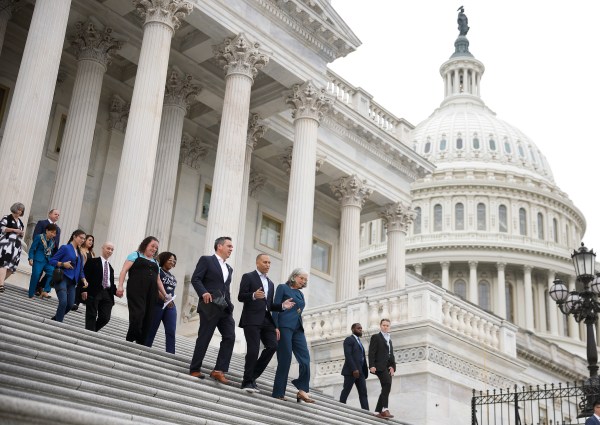Former President Donald Trump made a deal with pro-life groups during his 2016 campaign: He’d appoint Supreme Court justices who would overturn Roe v. Wade, and the pro-life groups would offer him political support. His recent comments on Meet the Press suggest he sees himself as having held up his end of the bargain and is ready to move on.
In describing Florida’s six-week abortion ban as “a terrible thing and a terrible mistake,” Trump showed his lack of commitment to the pro-life cause. But his statement also reflects a calculation that spurning the pro-life movement will not cause serious political consequences. And for many social conservatives, the uncomfortable truth in the president’s remarks is that the pro-life cause is struggling when placed in front of voters.
For half a century, the pro-life movement was forced to rely primarily on a legal strategy to protect the unborn child. The conservative legal scholar Ed Whelan, my colleague at the Ethics and Public Policy Center, called the Dobbs decision the “crowning achievement of the conservative legal movement.” But that legal victory, while necessary, only put the pro- and anti-abortion forces on a level political playing field. It didn’t win the contest. And since then, the scoreboard is telling an ugly story.
Kansas voters rejected a pro-life ballot amendment by 18 points in August 2022. Three months later in Kentucky, which voted for Trump by 26 points in 2020, a similar measure failed by 5 points. Montana, another red state, voted down an amendment that would have required medical care to be provided to infants who survived an abortion attempt. Two-thirds of voters in California, and three-quarters of voters in Vermont, approved broadly worded amendments guaranteeing an individual’s right to “reproductive freedom.” A similarly sweeping abortion referendum in Michigan passed by 13 points. And most recently, voters in Ohio turned down a constitutional amendment largely seen as a proxy fight over abortion rights by 14 points.
The abrupt shift into a world of direct democracy has left the pro-life movement exposed. The question can’t help but linger in some conservatives’ minds: Why weren’t pro-lifers better prepared for a post-Roe America?
The reasons for the rocky aftermath of Dobbs might be broadly grouped into three categories: structural factors, short-term strategic choices, and the “unbundling” of the coalition to overturn Roe.
The structural forces biased against the pro-life cause are easiest to see. It’s no secret many social conservatives feel the mainstream press is biased in favor of abortion, and rightly so. In the wake of Dobbs, a truly shocking amount of misinformation went viral online, often egged on by credulous legacy media outlets. There were claims that abortion bans would prevent treatment for ectopic pregnancies or miscarriage, or that they would cause skyrocketing maternal mortality. Conservatives suspect, perhaps correctly, that “abortion supporters are creating this chaos on purpose,” in order to discredit pro-life legislation.
Similarly, pro-choice groups benefit from a vast array of left-wing philanthropy and advocacy dollars. Major left-leaning foundations such as the Ford Foundation, the Hewlett Foundation, the Open Society Foundation give generously to reproductive rights initiatives. In Michigan, the coalition supporting the expansive abortion amendment reported $45 million in contributions, more than twice the $20 million recorded by the opposition campaign.
Yet noting the bias of the mainstream media or pointing out the deep pockets funding the other side is a bit like yelling at the referees—no matter how egregious the bias, you still have to play the game. Ultimately, changing hearts about the morality of abortion is the most reliable way pro-life legislation will win over the long run—a task made more difficult when opponents of abortion are constantly on defense.
Pro-life activists know they can’t rely on celebrity endorsements or big spending to push their message across in hostile waters, but must make the case for the humanity of the unborn fetus and what it means for a society to rely on lethal violence to remedy the “problem” of an unplanned pregnancy. Allowing arguments to get bogged down over exceptions in difficult edge cases (like rape and incest, which traditionally account for less than 2 percent of all abortions) make it harder for the pro-life cause to make headway.
In response, many social conservatives have focused on the extremism of the other side. In deep blue California, for example, combatting the proposed expansion of abortion rights was always going to be an uphill battle. But Molly Sheahan, an associate director at the California Catholic Conference, told me that one of the most effective messages in their work was focusing on late-term and taxpayer-provided abortion. “Even some pro-choice people have concerns about it,” she said. “When we were able to reach people with that messaging, it did help close the [polling] gap; even progressive folks are opposed to taxpayer funding of late term abortion for healthy moms and healthy babies.”
That is a necessary tactic, but the results from the state referenda suggest it is not sufficient. And some of the strategic choices made by pro-life advocates struck some observers as lacking message discipline.
As NBC News reported, some ads on the abortion referenda in Ohio and Michigan warned voters about their potential to permit teens to undertake gender-transition surgery without parental consent. A major ad campaign on Ohio’s constitutional amendment never even mentioned the topic of abortion, but warned about “trans ideology in classrooms and … sex changes for kids.” To some voters, ads that focused on drag queen story hours may have seemed like attempts to change the subject, and may not have appealed to pro-life voters less convinced by the proposed linkage between abortion and battles over gender ideology.
One individual who had helped lead local efforts against a state abortion referendum, speaking on condition of anonymity, told me that “D.C. consultant elites” had brought in public relations strategies that weren’t well suited for the concerns of everyday voters. “Branding has its place but it’s not the decisive factor. …We needed to be talking about being pro-woman, pro-child, making it easier for choose life.”
Sheahan saw some of these concerns firsthand. There are “real concerns about maternal mortality [and] the health and safety of women that need to be addressed,” she said, for the pro-life movement to make strides forward. “If we’re serious about these moms and families, what sort of resources are we devoting to them. …What do families need, practically?” Funding for pregnancy resource centers is valuable and necessary, Sheahan said, but needs to be supplemented with meaningful material support in areas like “paid family leave, child care, housing, health care,” and other safety-net supports.
And there is some evidence these approaches can pave the way for pro-life legislation, even if they are not the decisive factor. North Carolina, perhaps the most politically divided state yet to have successfully passed an abortion ban, did so by negotiating a wide array of social supports for pregnant moms.
But that kind of political negotiation requires some political muscle—muscle that hasn’t been flexed since the Supreme Court took state legislation off the table. To some degree, Roe was the glue holding together a broader conservative coalition, of which social conservatives made up a large, but not total, portion. With Roe gone, pro-lifers found some of their allies considered the job more or less completed.
In the years immediately preceding Roe v. Wade, more than half the states in the union, from Georgia to Montana, successfully stopped proposals to loosen abortion restrictions. In 1973, the court effectively halted the democratic working-out of the topic, finding a supposed constitutional right to abortion. One could even find some liberal legal scholars agreeing that Roe, with its vast scope and specious logic, was a poor piece of jurisprudence, making it the perfect target. (Indeed, its 1992 sequel, Casey v. Planned Parenthood, was seen as essentially rescuing the finding in Roe by putting it on slightly more solid footing.)
The egregiousness of Roe brought together the rightward-leaning legal movement, federalism-minded conservatives, and religious activists convinced of the moral value of the unborn child. The path forward wasn’t easy. But, crucially, it was well-defined: Get a minimum of five justices willing to overrule Roe onto the high court. As UC-Davis law professor Mary Ziegler writes in her history of the GOP’s relationship with pro-lifers, “the promise of controlling the Court could unite a fractious coalition and turn out [pro-life] voters who might otherwise not care about a particular race.”
But with that goal accomplished, the different camps that came together to overturn Roe have effectively been unbundled. A legal-first strategy was the necessary and correct approach. But in the months since, it has sometimes felt like the pro-life movement is sometimes stuck bringing legal knives to an electoral gunfight. Matthew Walther, the fiscally liberal and socially conservative editor of a Catholic literary magazine, suggested that in the Dobbs decision, “Originalism has won the day, but the anti-abortion cause has not.”
Certainly, some states have used the new latitude created by Dobbs to take action. “A dozen or more states began to enforce their laws immediately after Dobbs,” Clarke Forsythe, senior counsel at Americans United for Life, told me. “That can’t be discounted.” According to Planned Parenthood’s tally, 20 states currently have restrictions on the books that would have been disallowed under the Roe regime. In states without an initiative or amendment process, any change to those laws would need to be effected through future legislation or a state court ruling.
But 26 states provide for at least one form of a statewide, citizen-initiated ballot measure—and according to the New York Times’ Emily Bazelon, future amendment campaigns are “either underway or being explored in Florida, Arizona, Missouri, South Dakota, Colorado, Idaho and Nebraska.” Consider, too, that state Supreme Courts do not operate in a vacuum. If pro-life legislation continues to struggle at the ballot box, judges who might be predisposed to find a “right” to abortion in their state constitution (as eight already have on the books) may feel increasingly emboldened. Until the pro-life movement demonstrates an ability to garner support from a healthy slice of the electorate, it should treat very few states as safe.
A smaller-scale disintegration is also apparent. Any talk of the “pro-life movement” has always been shorthand for various disparate groups that agree on an ultimate goal but disagree about how to get there, such as the debate between the “incrementalist” and “abolitionist” wings. The post-Roe version of the pro-life movement has amplified those tendencies. “The infighting hasn’t gone away,” the state leader I talked to said. “No one did any long-term planning for a post-Roe regime.”
A South Carolina Supreme Court decision forced the state legislature to tackle the question of abortion post-Dobbs. Hardliners, who wanted a ban on abortion with no exceptions, fought moderates, who sought a six-week ban with exceptions for rape and incest, to a draw—with the result that no bill was able to pass until the subsequent legislative session. Ohio’s various pro-life factions were also at odds in the weeks leading up to the state’s constitutional amendment. Some pro-life groups that describe themselves as “abolitionist” encouraged lawmakers to take up a bill that would have subjected women seeking abortions to criminal and civil penalties. Other groups signed onto a letter urging policymakers to “reject any measure that seeks to criminalize women who have abortions,” and the back-and-forth spilled into the press.
In 2007, the late Fr. Richard John Neuhaus exhorted readers of the journal he founded, First Things, to continue their advocacy for the creation of a “culture of life” and the end of Roe. “The culture of death is relentless but not unstoppable,” he wrote. “The sign of its being arrested, if not defeated, will be the reversal or judicial shelving of Roe v. Wade.”
This pro-lifer hopes Fr. Neuhaus’ words will prove prophetic in time. But the immediate aftermath of the long sought-for end of Roe has been a cultural shift against the movement that would protect unborn life. Polling from Gallup shows the share of Americans who believe abortion should be legal under any circumstances has risen to 34 percent post-Dobbs, an all-time high.
Instead of the clarity of the goal of getting five justices on the court who would overturn Roe, the pro-life movement is faced with messy questions of prudence, public opinion, and to what degree politics should be the art of the possible. As Forsythe told me, “No one can think we can erase the negative cultural impact of Roe in a year, the negative impact of the Court imposing the logic of abortion on demand. … Did we understand what we were talking about for 50 years?”
The pro-life movement knows a thing or two about long odds and lengthy fights. But the work of protecting the unborn will be made more difficult if more states continue to write unbridled rights to “reproductive autonomy” into their constitutions. As such, it’s crunch time for religious and social conservatives: Figuring out how to stem the bleeding at the ballot box or the court of public opinion may be the most likely way to avoid future politicians following the former president’s lead in throwing them under the bus.







Please note that we at The Dispatch hold ourselves, our work, and our commenters to a higher standard than other places on the internet. We welcome comments that foster genuine debate or discussion—including comments critical of us or our work—but responses that include ad hominem attacks on fellow Dispatch members or are intended to stoke fear and anger may be moderated.
With your membership, you only have the ability to comment on The Morning Dispatch articles. Consider upgrading to join the conversation everywhere.